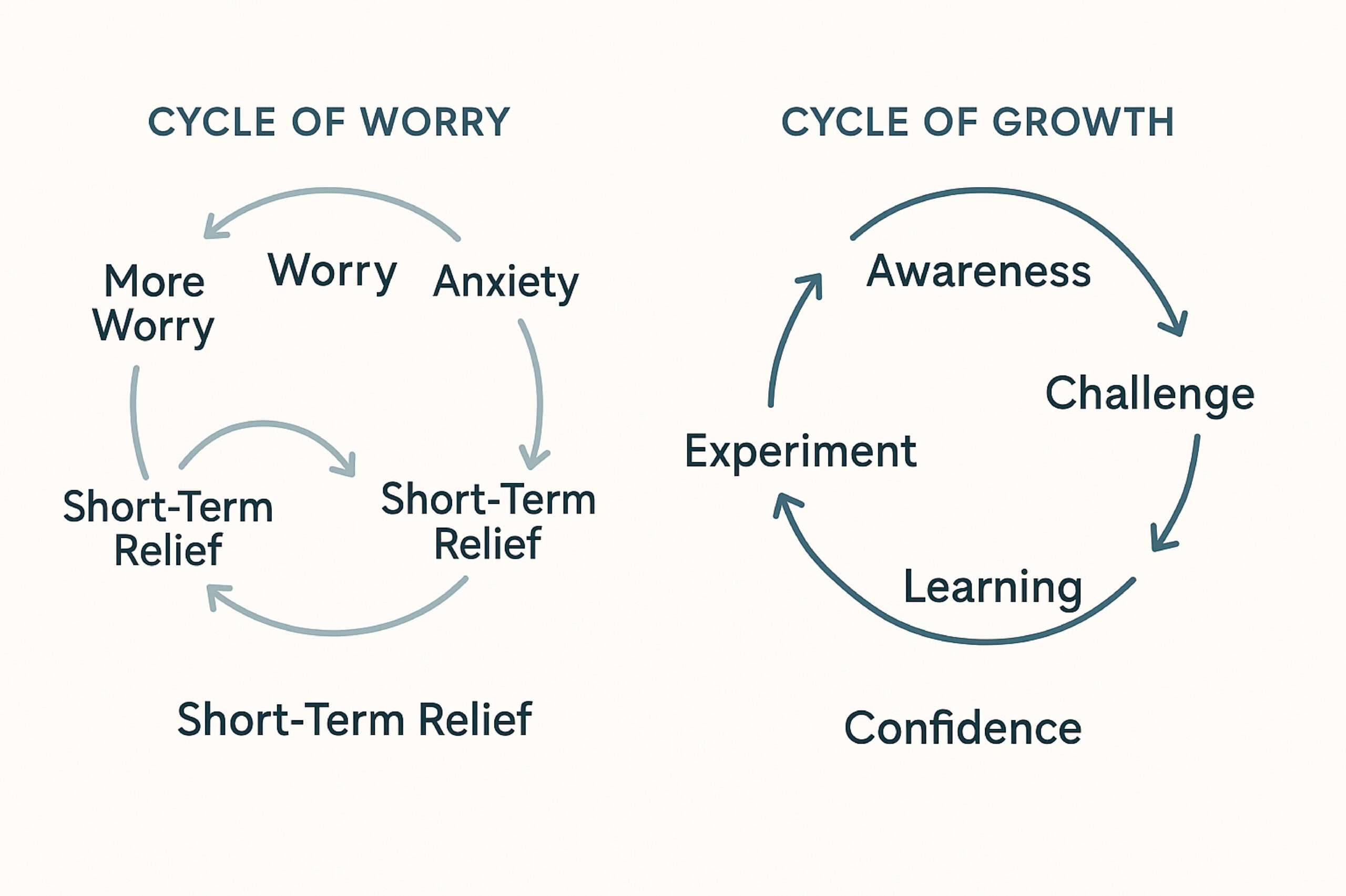Cognitive Behavioral Therapy for Generalized Anxiety Disorder: A Modular Approach
Written by: Brittany Bayer, LCPC
Generalized Anxiety Disorder (GAD) is often referred to as the “common cold” of anxiety disorders. GAD is characterized by persistent and excessive worry, often driven by intolerance of uncertainty and reinforced by unhelpful coping strategies. Cognitive Behavioral Therapy (CBT) remains the gold standard for treating GAD, as outlined in Melisa Robichaud and Michel Dugas’ Generalized Anxiety Workbook. Using the concepts, exercises, and strategies from their work, a modular approach emerges that allows clinicians to target the specific mechanisms that maintain worry, anxiety, and avoidance.
This month’s journal club summarizes a five-module framework designed to help individuals better understand, evaluate, and change their relationship with worry, as well as to make behavioral changes that increase confidence to live more fully.
Module 1: Understanding Worry and Anxiety
Worry can be conceptualized as a mental behavior—a repetitive cycle of both imagining negative outcomes and mentally preparing for them. Anxiety, in contrast, is the emotional and physiological state triggered by perceived threats, activating the brain’s “alarm system” and body’s stress response. Within the context of GAD, perceived threats are often detected in unpredictable, novel, and/or ambiguous situations—all of which have one thing in common: uncertainty.
Module 2: Is Worry Helpful?
Although many clients come to therapy seeking relief from their worries and anxiety—thus viewing worry as something to get rid of—many of those with GAD hold strong beliefs about the utility or benefits of worry. Specifically, worry can be seen as protective or necessary for preparedness, or perhaps an indicator of a positive personality trait (e.g., conscientiousness, detail-oriented, caring). But, if therapy is supporting clients with worrying less, doesn’t that mean they will miss out on all these benefits? Perhaps, but also, perhaps not.
This is why CBT uses a technique called “putting beliefs on trial”, where these ideas about the usefulness of worry are examined much like evidence in court. By assuming the roles of the defense, the prosecution, and the judge, clients thoughtfully examine their own beliefs about worrying. Many experience an “Aha!” moment in which they realize that, hey! Worry is not as useful as I once thought.
Module 3: Intolerance of Uncertainty & Safety Behaviors
Uncertainty is a core driver of GAD. Many clients see uncertainty as inherently negative and threatening. Just as clients with GAD often hold beliefs about the utility of worry, they hold beliefs about uncertainty itself. For example, many individuals believe that uncertain situations are bound to result in bad outcomes. Further, many individuals believe that they would be incapable of navigating bad outcomes in the event that they do occur.
To cope with this uncertainty, individuals may develop safety behaviors—deliberate actions taken to reduce anxiety, prevent feared outcomes, and/or to minimize uncertainty. Examples of safety behaviors include, but are not limited to, reassurance seeking, excessive list-making, procrastination, or avoiding decisions. While these behaviors temporarily relieve distress, they ultimately reinforce worry as well as the belief that uncertainty is inherently negative and something to be avoided. This module helps clients to identify their own safety behaviors and understand their function in maintaining anxiety and worry.

Module 4: Behavioral Experiments
CBT emphasizes experiential learning to challenge worry. Clients are encouraged to enter unpredictable, novel, or ambiguous situations while deliberately reducing or eliminating safety behaviors. This process, known as behavioral experimentation, allows individuals to directly test their beliefs about uncertainty and learn through real-life evidence rather than relying only on reasoning. Clients often walk away from this experimentation with new learning, increased confidence in one’s coping ability, and improved trust in their ability to tackle uncertain situations in the future.
Module 5: Worries About Current Problems
What is the difference between worrying and problem solving? This is a million-dollar question, especially if someone believes that worry helps them to problem solve. Worrying about a problem is often a passive thought-related process that doesn’t result in taking action, whereas problem solving is active. Some aspects of the problem-solving process—defining the problem and generating possible solutions, for example—require us to think. However, unlike simply worrying about a problem, solving it moves from thoughts to action. This module helps clients to think about their problems—and possible solutions—in a more productive way than just worrying.
Many individuals with GAD have a negative problem orientation, believing that problems are threatening and that their own abilities to problem solve are severely lacking. Using the problem-solving process outlined in this module (Define the Problem, Formulate a Goal, Generate Solutions, Make a Decision, Implement the Chosen Solution, and Assess Solution Efficacy) acts as a behavioral experiment to test the beliefs common in a negative
problem orientation. As a result, many find that their beliefs about problems and their abilities to solve them were initially misguided, and many can shift to a more positive—or even neutral—attitude toward problems, seeing them less as threats and more as opportunities.
Conclusion
For both clinicians and clients, the impact of GAD can seem pervasive such that it feels difficult to tackle. No matter the number of or variety among themes about which an individual worries, this modular CBT approach for GAD provides a structured yet flexible roadmap for therapeutic work. This modular approach is easily tailored to individual or group work, thereby increasing its overall versatility. Each module presents digestible, practical, and effective strategies to support clients with leading more confident and empowered lives!
About Us
Learn moreOur Care
Learn moreWhat We Treat
Learn more